Why We Need Extra Water When Boondocking
We boondock most of the time, which means water is a big deal to us.
We need enough water to drink, do dishes, shower, and do laundry when camping without hookups.
Related Product: We level our RV with the innovative Andersen RV Leveling Set (click to view on Amazon)
The fresh water tank in our travel trailer holds around 45 gallons. Our grey and black tank combined will hold 70 gallons of wastewater.
Because we have so much extra holding tank space, we store an extra 35 gallons of potable water in the bed of our truck using these square Reliance 7 gallon water jugs (click to view on Amazon).
See Also: Best RV Water Hose For Drinking Water
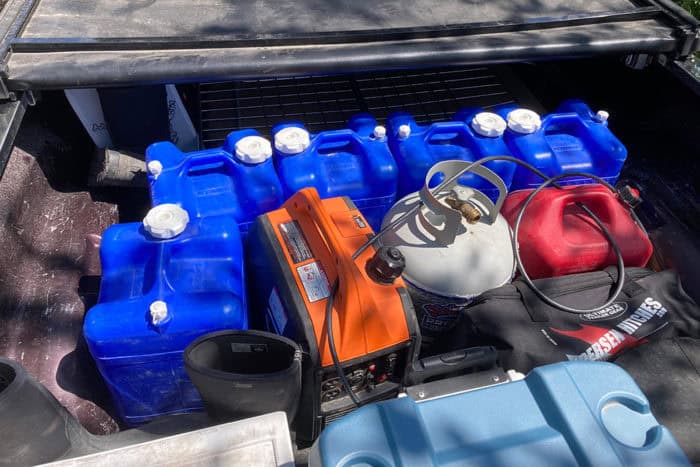
We use jugs instead of water bags because we like to have extra water with us always.
They fit perfectly under our truck bed cover and we can use them to get water at filtered water dispensers like the ones found outside grocery stores and gas stations if we can’t find a hydrant with potable water anywhere else.
(This happens a lot in places like Arizona where free or affordable freshwater can be difficult to find)
With the extra water, we can boondock comfortably for about 10 days at a time. We make coffee and cook with the water in our fresh tank, so everything fits in the black and grey tanks.
Also, if we ever need a little more water for whatever reason, it’s usually just a quick trip to fill the jugs somewhere.
See Also: Best Portable Power Station/Solar Generator For Camping
How We Get The Water From The Jugs To The RV
Lots of people use jugs to get extra water, but the question people always ask us is how we get the water into the fresh water tank without a ton of work or losing a bunch of water.
Our solution is to use an RV water pump and a hose that’s approved for potable water.
The Water Pump
The reason RV water pumps are perfect for pumping water from jugs to a tank is they are diaphragm pumps.
Diaphragm pumps can pump both air and water without getting damaged, which is nice since you will end up getting quite a bit of air in the line when the jugs are empty and you transfer the hose from one jug to another.
Most RV water pumps are 12 volt pumps like this one (click to view on Amazon).
People who use the 12 volt RV water pumps hook them directly to their trailer or truck batteries using alligator clips like these (click to view on Amazon).
This is great if you don’t have a generator with an outlet, a solar set-up, or a portable solar power station. It’s also a good water pump to have just in case the one in your RV goes out and you need a replacement.
See Also: Best RV Water Filter Systems & Cartridges Reviewed
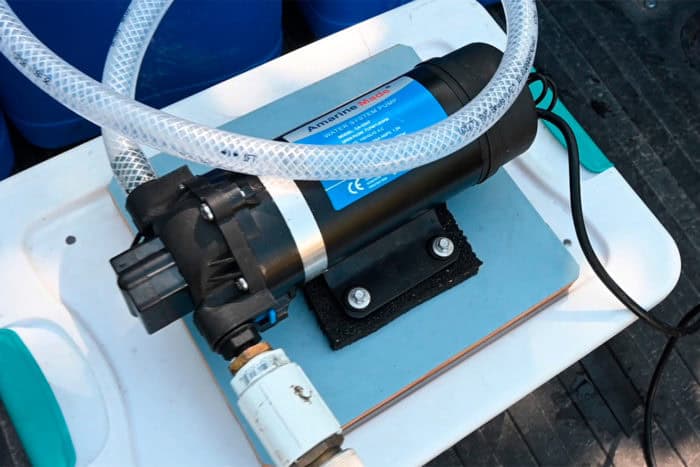
I went with the Amarine Made AC RV Water Pump (click to view on Amazon.
The only difference between my RV water pump and a 12 volt one is mine has a regular plug you can use in a standard wall outlet like the ones found in a home.
Which means you don’t need to get anything extra to get the pump running so long as you have a powered outlet.
See Also: The Best Way To Do Laundry When Camping With Limited Water
I normally use our Jackery 500 Power Station (click to view on Amazon) or our Bluetti (click to view latest model on Amazon).
They both have an outlet I can plug the pump into. When we are low on power, I plug the pump into our inverter generator.
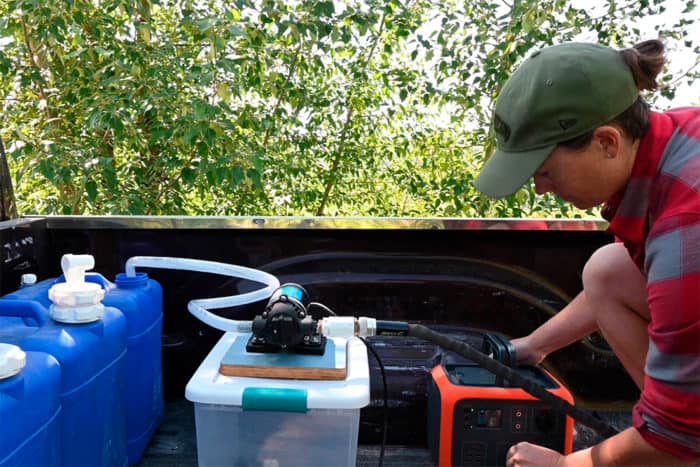
One great thing about having a power station is most of them have a 12V DC power source and an AC one.
If you have a 12V water pump, you could attach a 12V plug like this one (click to view on Amazon) and power it with a solar power station.
We’ve been using our Amarine Made AC RV water pump regularly for over a year and it’s still working great.
I mounted it to a board with a piece of rubber mat in between so it has something to sit on when it’s running and so far it’s been quiet and pumps water quickly, even through a 50-foot hose, which I’ll talk about next.
The Hoses
Originally, I purchased 6 feet of 1/2 inch clear braided PVC tubing (click to view on Amazon) that I cut in half and connected to the two barb adapters that came with the RV water pump.
On the water intake tubing end, I put a 3/4 inch PVC end cap (click to view on Amazon) on using a 1/2 inch barb adapter (click to view on Amazon) and drilled holes in it to keep it from vacuuming to the bottom of the jug.
The outtake end I left open, and I put that end into the fresh water tank when I have the jugs near the trailer.
See Also: How To Install Solar Panel On RV Roof & Connect To Battery
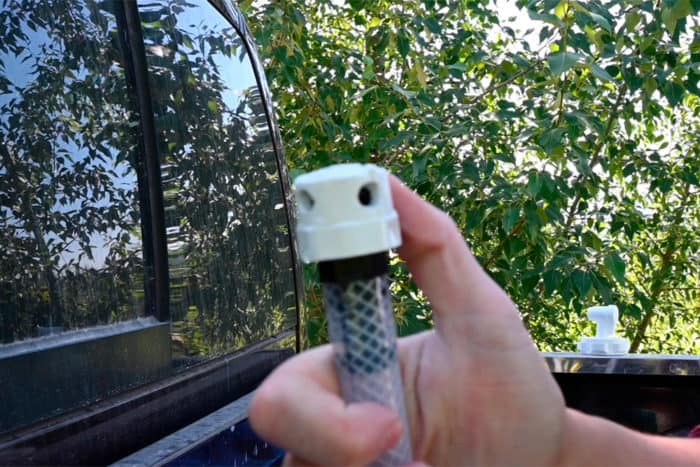
Most of the time for the outtake end I connect our 50 foot zero g hose (click to view on Amazon) so I can pump the water from the jugs in our truck bed and I don’t have to carry them all the way to the travel trailer.
This system is much nicer and takes a lot less work.
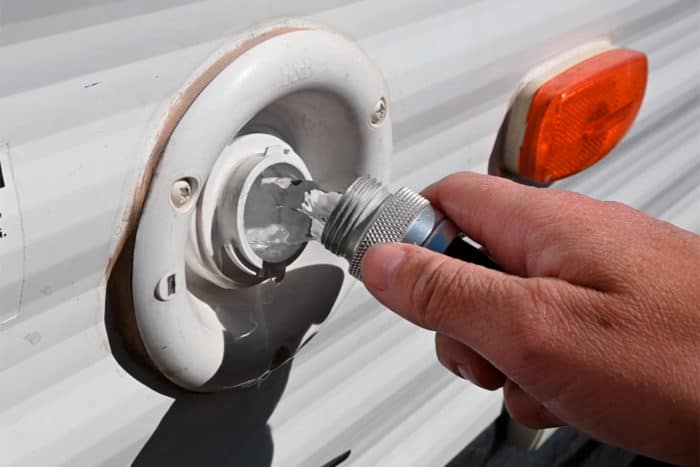
The pump came with 4 adapters. Two were the kind you can push tubing onto and the other two are 1/4 inch threaded.
You will need to make an adapter to turn the 1/4 inch male to a male hose.
I did this with a 1/2 inch to 1/4 inch reducer (click to view on Amazon), a 1/2 inch coupling (click to view on Amazon), and a 1/2 inch to 3/4 inch garden hose male adapter (click to view on Amazon).
It’s not pretty and you are putting a PVC fitting into a brass one, but it does the job. Just make sure you use lots of plumber’s tape.
See Also: 10 Ways To Make Your RV Fresh Water Tank Last Longer
Storage
Everything fit nicely in a small tub I got from the local dollar store. All I did was drill holes in the lid so the pump can breathe and dry properly.
Conclusion
The entire process only takes around 30 minutes. That’s with setting up and putting everything away.
The pump is surprisingly fast and the 35 gallons of water get transferred quickly.
Bringing extra freshwater with you camping can make everything a little more comfortable and it’s especially worth it if you want to spend more than a week at a campsite.
See Also: Best Heated Water Hoses For RV Campers, Barns & Livestock
To balance the water in our grey and black tanks, we will do things like save our shower and dishwater and dump it down the toilet and into the black tank.
This helps keep the black tank from clogging, and it makes dumping the RV much faster.
If you have questions about transferring extra freshwater to your RV leave a comment below.

